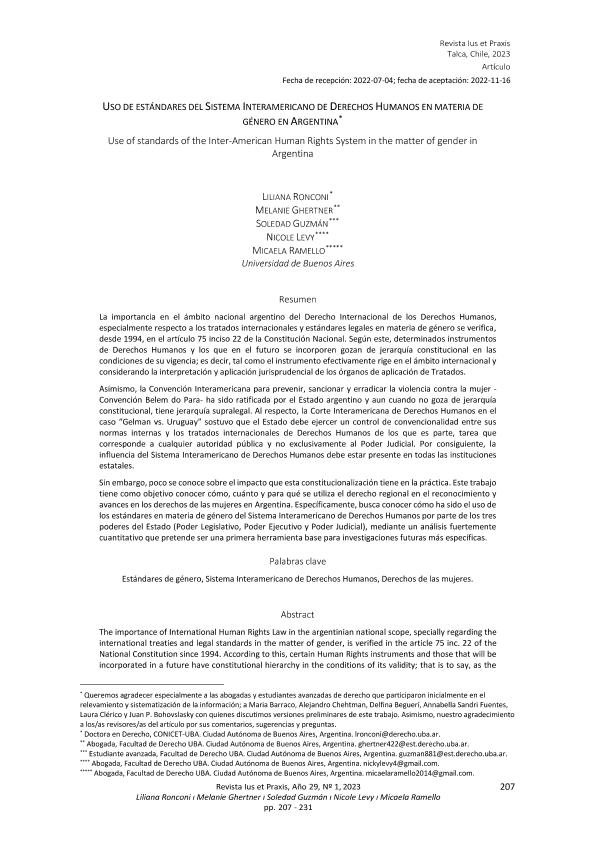Mostrar el registro sencillo del ítem
dc.contributor.author
Ronconi, Liliana Mabel

dc.contributor.author
Ghertner, Melanie
dc.contributor.author
Guzmán, Soledad
dc.contributor.author
Levy, Nicole
dc.contributor.author
Ramello, Micaela
dc.date.available
2023-12-26T15:11:42Z
dc.date.issued
2023-03
dc.identifier.citation
Ronconi, Liliana Mabel; Ghertner, Melanie; Guzmán, Soledad; Levy, Nicole; Ramello, Micaela; Uso de estándares del Sistema Interamericano de Derechos Humanos en materia de género en Argentina; Universidad de Talca; Ius et Praxis; 29; 1; 3-2023; 207-231
dc.identifier.issn
0717-2877
dc.identifier.uri
http://hdl.handle.net/11336/221416
dc.description.abstract
La importancia en el ámbito nacional argentino del Derecho Internacional de los Derechos Humanos, especialmente respecto a los tratados internacionales y estándares legales en materia de género se verifica, desde 1994, en el artículo 75 inciso 22 de la Constitución Nacional. Según este, determinados instrumentos de Derechos Humanos y los que en el futuro se incorporen gozan de jerarquía constitucional en las condiciones de su vigencia; es decir, tal como el instrumento efectivamente rige en el ámbito internacional y considerando la interpretación y aplicación jurisprudencial de los órganos de aplicación de Tratados. Asimismo, la Convención Interamericana para prevenir, sancionar y erradicar la violencia contra la mujer -Convención Belem do Para- ha sido ratificada por el Estado argentino y aun cuando no goza de jerarquía constitucional, tiene jerarquía supralegal. Al respecto, la Corte Interamericana de Derechos Humanos en el caso “Gelman vs. Uruguay” sostuvo que el Estado debe ejercer un control de convencionalidad entre sus normas internas y los tratados internacionales de Derechos Humanos de los que es parte, tarea que corresponde a cualquier autoridad pública y no exclusivamente al Poder Judicial. Por consiguiente, la influencia del Sistema Interamericano de Derechos Humanos debe estar presente en todas las instituciones estatales. Sin embargo, poco se conoce sobre el impacto que esta constitucionalización tiene en la práctica. Este trabajo tiene como objetivo conocer cómo, cuánto y para qué se utiliza el derecho regional en el reconocimiento y avances en los derechos de las mujeres en Argentina. Específicamente, busca conocer cómo ha sido el uso de los estándares en materia de género del Sistema Interamericano de Derechos Humanos por parte de los tres poderes del Estado (Poder Legislativo, Poder Ejecutivo y Poder Judicial), mediante un análisis fuertemente cuantitativo que pretende ser una primera herramienta base para investigaciones futuras más específicas.
dc.description.abstract
The importance of International Human Rights Law in the argentinian national scope, specially regarding the international treaties and legal standards in the matter of gender, is verified in the article 75 inc. 22 of the National Constitution since 1994. According to this, certain Human Rights instruments and those that will be incorporated in a future have constitutional hierarchy in the conditions of its validity; that is to say, as the instrument effectively rules in the international scope and taking into consideration the interpretation and jurisprudential application of international treaty bodies. Likewise, the Interamerican Convention of the Prevention, Punishment and Eradication of Violence against Woman -Convention of Belem do Para was ratified by the argentinian State and despite not having constitutional hierarchy it has supralegal hierarchy. In this regard, the Interamerican Court of Human Rights in the case “Gelman vs. Uruguay” held that the State must exercise a conventionally control between its internal legislation and the international Human Rights treaties to which it is a party, duty that belongs to any public authority, not exclusively to the Judiciary. Therefore, Inter-American Human Rights System influence must be present in all State institutions. However, little is known about the impact that this constitutionalizing has in practice. This paper aims to know how, how much and for what the regional law is used in the recognition and advancement of women’s rights in Argentina. Specifically, it seeks to know how the gender standards of the Inter-American Human Rights System have been used by the three powers of the State (Executive Power, Legislative Power and the Judicial Power), through a quantitative analysis that aims to be a first base tool for more specific future research.
dc.format
application/pdf
dc.language.iso
spa
dc.publisher
Universidad de Talca
dc.rights
info:eu-repo/semantics/openAccess
dc.rights.uri
https://creativecommons.org/licenses/by/2.5/ar/
dc.subject
ESTÁNDARES DE GÉNERO
dc.subject
SISTEMA INTERAMERICANO DE DERECHOS HUMANOS
dc.subject
DERECHOS DE LAS MUJERES
dc.subject.classification
Otras Derecho

dc.subject.classification
Derecho

dc.subject.classification
CIENCIAS SOCIALES

dc.title
Uso de estándares del Sistema Interamericano de Derechos Humanos en materia de género en Argentina
dc.title
Use of standards of the Inter-American Human Rights System in the matter of gender in Argentina
dc.type
info:eu-repo/semantics/article
dc.type
info:ar-repo/semantics/artículo
dc.type
info:eu-repo/semantics/publishedVersion
dc.date.updated
2023-12-21T11:25:05Z
dc.identifier.eissn
0718-0012
dc.journal.volume
29
dc.journal.number
1
dc.journal.pagination
207-231
dc.journal.pais
Chile

dc.description.fil
Fil: Ronconi, Liliana Mabel. Consejo Nacional de Investigaciones Científicas y Técnicas; Argentina. Universidad de Buenos Aires; Argentina
dc.description.fil
Fil: Ghertner, Melanie. Universidad de Buenos Aires; Argentina
dc.description.fil
Fil: Guzmán, Soledad. Universidad de Buenos Aires; Argentina
dc.description.fil
Fil: Levy, Nicole. Universidad de Buenos Aires; Argentina
dc.description.fil
Fil: Ramello, Micaela. Universidad de Buenos Aires; Argentina
dc.journal.title
Ius et Praxis
dc.relation.alternativeid
info:eu-repo/semantics/altIdentifier/url/https://www.scielo.cl/scielo.php?script=sci_arttext&pid=S0718-00122023000100207&lng=en&nrm=iso&tlng=en
dc.relation.alternativeid
info:eu-repo/semantics/altIdentifier/doi/http://dx.doi.org/10.4067/S0718-00122023000100207
Archivos asociados
